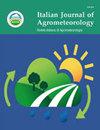Effect of drought and nitrogen fertilisation on quinoa (Chenopodium quinoa Willd.) under field conditions in Burkina Faso
IF 1.6
4区 农林科学
Q2 AGRONOMY
Italian Journal of Agrometeorology-Rivista Italiana Di Agrometeorologia
Pub Date : 2019-06-03
DOI:10.13128/IJAM-289
引用次数: 21
Abstract
Chenopodium quinoa (Willd.) is an herbaceous C3 crop originating in the Andean Altiplano. Quinoa possesses a great deal of genetic variability, can adapt to diverse climatic conditions, besides of having seeds with high nutritional properties. An experiment conducted in Burkina Faso has determined the response of two quinoa varieties (Titicaca and Negra Collana) to different planting dates (November vs December), irrigation levels (Potential evapotranspiration-PET, 100, 80 and 60% PET), and N fertilization rates (100, 50 and 25 kg N ha-1). Main research findings have shown that quinoa can be highly performant under drought stress conditions and low nitrogen inputs, besides of coping with high temperatures typically of the Sahel. The highest yields (1.9 t ha-1) were achieved when sown in November at 60 % PET and 25 kg N ha-1. For this location, short cycle varieties, such as Titicaca, were recommended in order to avoid thermic stress conditions occurring prior to the onset of the rainy season (May-October).干旱和氮肥对布基纳法索田间条件下藜麦(藜麦野生)的影响
藜麦(野生)是一种草本C3作物,原产于安第斯高原。藜麦具有很大的遗传变异,能适应不同的气候条件,而且种子营养价值高。在布基纳法索进行的一项试验确定了两个藜麦品种(Titicaca和Negra Collana)对不同种植日期(11月和12月)、灌溉水平(潜在蒸散量PET、100%、80%和60% PET)和施氮量(100、50和25 kg N ha-1)的反应。主要研究结果表明,除了应对萨赫勒地区典型的高温外,藜麦在干旱胁迫条件和低氮投入下也能表现优异。在11月播种时,以60%的PET和25公斤N / hm -1,获得最高产量(1.9 t hm -1)。对于这个地区,推荐短周期品种,如提提卡卡,以避免在雨季(5月至10月)开始之前发生热应激条件。
本文章由计算机程序翻译,如有差异,请以英文原文为准。
求助全文
约1分钟内获得全文
求助全文
来源期刊

Italian Journal of Agrometeorology-Rivista Italiana Di Agrometeorologia
AGRONOMY-ENVIRONMENTAL SCIENCES
CiteScore
2.10
自引率
8.30%
发文量
6
期刊介绍:
Among the areas of specific interest of the journal there are: ecophysiology; phenology; plant growth, quality and quantity of production; plant pathology; entomology; welfare conditions of livestocks; soil physics and hydrology; micrometeorology; modeling, simulation and forecasting; remote sensing; territorial planning; geographical information systems and spatialization techniques; instrumentation to measure physical and biological quantities; data validation techniques, agroclimatology; agriculture scientific dissemination; support services for farmers.
 求助内容:
求助内容: 应助结果提醒方式:
应助结果提醒方式:


